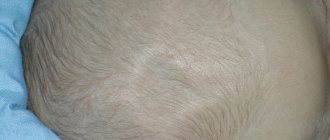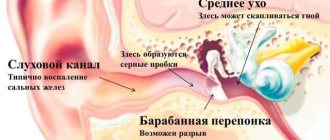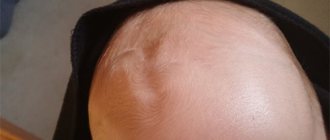Why does a newborn need a fontanel?
When the baby is still developing in the mother’s belly, his skull is first a membranous formation covering the brain on top. Bone tissue is gradually formed and bones are formed. But between them there remain membranous areas - narrow stripes and wider spaces, which are called fontanelles in newborns.
In fact, there is not just one fontanel - there are six of them. It's just that parents usually watch the largest one - the rhomboid, which is located at the junction of the frontal and parietal bones and takes much longer to heal than the others. The lateral fontanelles, located in the temporal region, close first. There are four of them in total - two mastoid and two wedge-shaped. They are tightened by bone tissue when the baby is in the womb, or in the first month after birth. Another fontanel - posterior - is located on the back of the head and has a triangular shape. It also overgrows in utero, or during the first two months of life.
The main mission of fontanelles is to help the baby be born. They allow the bones of the skull to move during childbirth to adjust the shape of the baby's head to the mother's birth canal.
Due to this deformation, children are born with an ovoid skull shape. Within a few days, the head takes on a normal appearance, and this is again thanks to the “cranial windows”. The role of the large fontanel does not end there - all the time until it closes, it will participate:
- in regulating the heat exchange of the child’s body: if the temperature rises, it will remove excess heat from the meninges;
- brain development: will help the skull grow, adapting to the growing brain;
- shock absorption: will soften the impact if the child falls and hits his head.
A large fontanelle also helps doctors. They learned how to perform neurosonography through the membranous membrane - the safest possible ultrasound examination that allows you to assess the health of the newborn’s brain. For pediatricians, the soft crown tells them about the baby’s health status and warns them if something goes wrong.
First aid
Mild signs of a concussion in a child immediately after a bruise may give way to a more serious condition. Therefore, it is important to provide first aid to the victim even before the arrival of doctors, after the first appearance of the first symptoms of a concussion.
When should a large fontanel close?
In 1982, WHO studied statistics on the fontanelles of children around the world and found that the crown normally closes in the period from 8 to 18 months. But sometimes this happens much earlier, for example at 3 months, or later - at two years. Pediatricians note that there is often nothing wrong with this either; the most important thing is that nothing bothers the child, and that he is regularly examined by a doctor. Each baby develops individually and how quickly the large fontanel closes can be influenced by:
- Hereditary predisposition. WHO scientists note that it is genetics that largely determine how the fontanel will heal in a newborn.
- The gestational age at which the child was born. In premature babies, the crown may take longer to close.
- Concentration of calcium and vitamin D in the body. If they are deficient, the “cranial window” may take longer to heal.
- Nutrition. If the baby eats well and gains weight, this contributes to the rapid overgrowth of the fontanel.
- Gender of the newborn. It is believed that in boys the membranous tissue of the skull is replaced by bone tissue faster than in girls.
But the size of the “cranial window” has nothing to do with the speed of its closure. One baby may be born with a small fontanel, which will take a very long time to heal. The other one is large, but it will immediately begin to rapidly decrease in size.
The very definitions “small” and “large” are relative to the fontanel. You can find out what it should be normally by focusing on the very approximate figures given in the table. To measure the fontanel, take a measuring tape and look at the distance between the opposite sides of the “diamond”.
Scheme for measuring the fontanel
Interestingly, in the first days of a baby’s life, the size of the soft crown may increase in size. This is due to the fact that the shape of the skull changes. Then the “cranial window” will only get smaller.
Organization of the daily routine
The main task of parents is to provide bed rest for the child. The room needs to be kept at a cool temperature and ventilated frequently. It is better if the curtains in the room are drawn to provide twilight. After a concussion, a child is prohibited from:
- Play outdoor games.
- Read books, comics, draw.
- Watch TV; cartoons and programs on the computer.
- Play electronic games: on the phone, computer, Tetris.
- Listen to loud music.
- Talk on the phone for a long time.
If a child is diagnosed with a concussion, he must remain in bed for at least 5 days. The period of rest may be longer, it depends on the severity of the injury, the characteristics of the little patient’s body, and the progress of recovery. For treatment at home, you can use soothing herbal teas: chamomile, lemon balm, peppermint.
Attention! You can give medications to a small patient only after consulting a doctor.
Newborns recover faster than school- or kindergarten-age children. It is easier for them to organize a calm regime and eliminate irritants in the form of loud sounds and bright lights.
After a couple of weeks of following the regimen, the child’s condition returns to normal. Headache, nausea, dizziness disappear after 4-5 days. You can attend school or kindergarten approximately three to four weeks after a head injury, if permitted by a neurologist. Limiting physical activity at home and outside is necessary for about a month after recovery.
What can the rate of fontanelle closure predict?
There are diseases that can be recognized by the way the large fontanelle overgrows. Therefore, pediatricians examine the crown during each examination of the newborn. But the doctor also focuses on other symptoms that accompany severe pathologies. If the baby feels well and is developing normally, the doctor will explain that there is no reason to worry and will send you home. Rarely, but still there is a different development of the situation.
The fontanelle can heal quickly, up to 3-4 months, if the baby has craniosynostosis. This is a rare disease in which the cranial sutures close prematurely: the skull stops growing, becomes deformed, and intracranial pressure increases.
The newborn's head takes on an unnatural shape, and nausea, vomiting, headaches, and convulsions may begin. The disease is treated surgically.
Another pathology that is sometimes signaled by rapid overgrowth of the fontanel is microcephaly. It is even less common. The patient has a noticeable imbalance in proportions: a small size of the skull, with normal sizes of the rest of the body. The disease is accompanied by mental impairment. There is no special treatment for the disease.
Late closure of the fontanel, usually after one and a half years, may be one of the symptoms:
- Rickets, which develops due to vitamin D deficiency. Other symptoms: sweating and sour smell of sweat, itching, sleep disturbance, poor appetite, increased excitability. Premature babies are at risk. If treatment is started in a timely manner, the problem will be solved without consequences for the child.
- Achondroplasia is a congenital disease in which the growth of skeletal bones and the base of the skull is impaired. Often symptoms can be seen already in the first days after birth: enlarged head, short limbs. Patients are retarded in physical growth and dwarfism is diagnosed. Treatment is aimed at preventing and eliminating severe deformities.
- Hypothyroidism, a condition caused by a persistent lack of thyroid hormones. The child will begin to lag behind in mental and physical development, will be lethargic, drowsy, eat poorly, grow and gain weight. The patient is prescribed hormone replacement therapy.
- Down syndrome, chromosomal pathology. The disease is often detected early in pregnancy.
Functions
This area of the skull in a newborn plays an extremely important role:
- thanks to the fontanelles, the bones of the skull can overlap each other during birth, making it easier for the baby to pass through the birth canal;
- acts as a shock absorber when a child falls and hits his head, since thanks to it the bones of the skull remain quite mobile, and the brain rests against the connective soft tissue upon impact;
- participates in the process of regulating heat exchange, acting as a natural ventilation channel to cool the baby’s brain when adapting to temperature changes;
- allows children to undergo an ultrasound of the brain to identify possible pathologies;
- Thanks to it, the newborn’s brain has enough space to develop quickly and fully.
Why does the fontanel sink or protrude?
Normally, the fontanel is located at the level of the skull bones. But sometimes it can sink or protrude. Small deviations are acceptable; sudden changes can signal problems in the body. At the same time, other symptoms will appear: moodiness, poor sleep, nausea and vomiting, fever, convulsions, squint.
Bulging of the fontanelle in a newborn occurs with encephalitis, increased intracranial pressure, hemorrhage, and meningitis. If the bulge appears after the baby hits his head, the cause may be a concussion.
A sunken fontanel often alerts parents that the newborn is dehydrated. This happens especially often against the background of fever, diarrhea, and vomiting.
The body's loss of moisture may also be indicated by: dry skin, cracked lips, general malaise, constipation. It is important to consult a doctor and ensure your baby drinks plenty of fluids. The fontanelle will restore its shape as soon as the body’s water balance returns to normal.
What can happen if it is not treated?
A bulging fontanelle often signals a serious illness. This may mean there is fluid in or around the brain. This fluid can damage brain tissue, causing severe damage. The cause may be a serious infection or other injury that can be fatal. It must be scary to see a bulging fontanel, and parents are worried about painful treatment. However, the sooner the child receives treatment, the better the prospects. Even in cases of serious infection, timely treatment can improve the child's condition. Delay may cause permanent health problems.
Doctors should determine the cause of a bulging fontanelle as quickly as possible. Doctors may ask questions about the child's development, daily routine, and medical history, including whether the child has been sick recently. In addition, the doctor will take the child's temperature and perform a blood test. Your doctor may also order a brain scan. In many hospitals, doctors perform a lumbar puncture, called a spinal tap. A lumbar puncture involves inserting a needle into the area around the spine to remove a sample of cerebrospinal fluid.
Although this procedure is generally safe and the most accurate way to determine whether an infection is causing a bulging fontanel, it can be stressful. If a lumbar puncture shows that there is no infection and the doctor cannot determine the cause, he may recommend hospitalization of the child for observation. Treatment will depend on the cause. If your child has bacterial meningitis, he or she will need antibiotics. Some forms of congenital hydrocephalus require ongoing support and care, such as physical and occupational therapy. Children with head or spinal cord injuries also require ongoing care.
General recommendations
As a rule, the doctor at the appointment pays attention to the following details:
- is the fontanel open or closed and whether this corresponds to the age of the child (is the closure too early or too prolonged);
- the number of open fontanels at birth and the number of open ones at the time of examination;
- the rate of change in the size and shape of a given area compared to the previous inspection;
- How do its edges feel to the touch: elastic (normal) or excessively soft (possible development of rickets);
- whether it sticks out or, conversely, sinks.
If any suspicions arise during a medical examination, the following examinations and consultation may be prescribed:
- neurologist;
- endocrinologist;
- genetics.
You should take a urine test for the Sulkovich test to determine how well the newborn’s body absorbs calcium and do an ultrasound of the brain.
Many parents also often wonder: is it possible to somehow harm the baby by touching the fontanelle or pressing on it? No, the connective tissue and skin are strong enough to prevent this from happening. So you can comb, wash and independently inspect this area on your baby’s head without any fear.










